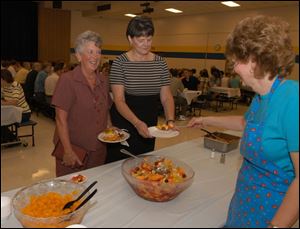
Ida and Jefferson keep alive practice of school-made meals
8/26/2004
Just as students will do next week, Barb Contat, a teacher from Monroe, and Cathy Griffith, Ida High School principal, receive breakfast fruit from cook Vivian Gross at Ida High School.
IDA - Maybe it's the trays and trays of steaming homemade lasagna. Or the fruit-filled desserts. Or the homemade pizza with all those market-fresh ingredients. Probably not the salmon loaf, though.
No matter the reason, students in only two Monroe County school districts will still line up - much as their parents did - for meals made by local women in a school kitchen. And though it costs cash-strapped Ida and Jefferson money each year to run their in-house food service programs, they wouldn't have it any other way.
"We've always been happy having our local people do [the cooking], and we feel they put out a better product," said Ida Superintendent Marv Dick. He speaks with some degree of expertise, given that he's eaten more meals in the Ida High School cafeteria over the last 35 years than just about anybody.
Seven school districts in Monroe County - Airport, Bedford, Whiteford, Summerfield, Monroe, Mason, and Dundee - rely on Chartwells Educational Dining Services to provide meals to students. The company, which serves more than 1.5 million meals each day in more than 500 school districts across the country, provides a nutritious, varied menu that includes offerings from some of the biggest names in the food service industry.
But for Ida and Jefferson, too many cooks just spoil the soup.
"I'm not trying to take away anything from food service companies,'' said David Houle, Jefferson's director of business and finance, "but quite frankly, when you bring in a food service company, you're bringing in another mouth to feed. Not only are you operating a food service program, but they also have to find some profit margin for them to pass along to their shareholders."
Mr. Houle, who also wears his district's biggest chef hat as the administrator who oversees the food service program, said his district's decision to stick with "self-operated" food service
has intangible benefit that can sometimes go missing from a sterile relationship with a subcontractor. "It's harder to do it this way in one sense, but the difference is you have your own employees coming face to face each day with their customers, our students."
Mr. Houle said. "Our employees bring a lot of professional expertise to the table."
The merits of cafeteria food will likely always be subject to debate, no matter what school one might hail from or in what era. But as school districts across Michigan struggle with state funding levels that either have been frozen or have fallen the last three years, the choice a district makes to cook its own food is one that has to be weighed carefully.
"We're not in [food service] to make money. If we broke even, we'd be happy," Mr. Dick said in justifying the school's annual $46,500 general fund expenditure to help underwrite the food program. "I think it's just sort of a nice touch."
At Bedford for instance, the district sees an annual "3 or 4 percent profit" into its general fund from its association with Chartwells. That's extra money that can be used in the classroom, said Ted Magrum, assistant superintendent for finance.
But at Ida, the personal touches that the 19 women who cook between 800 and 825 lunches a day make, is all the difference in the world, said Connie Guthrie, who oversees Ida's food service program.
"I'm very proud that our head cooks make all of these good hot meals from scratch," Mrs. Guthrie said, reeling off a menu deep and varied enough to make almost any mouth water, like homemade stir fry with diced chicken and fresh vegetables.
"It's not brought in frozen and heated up in a pan."